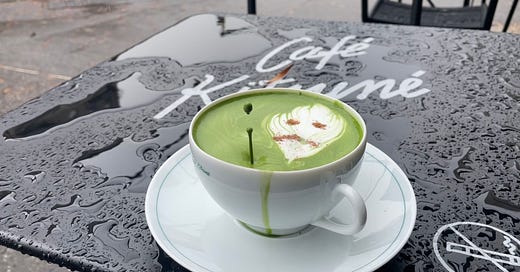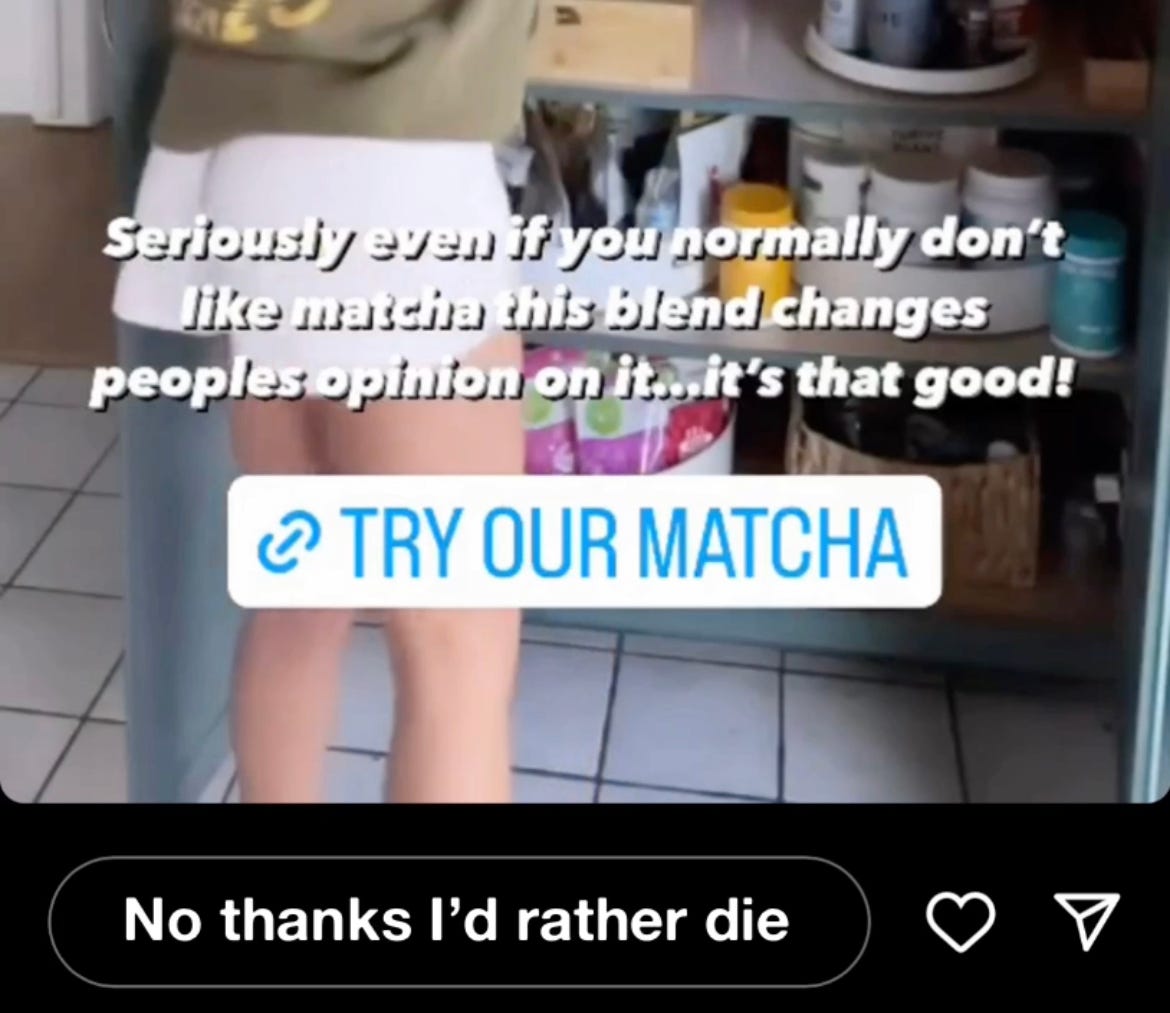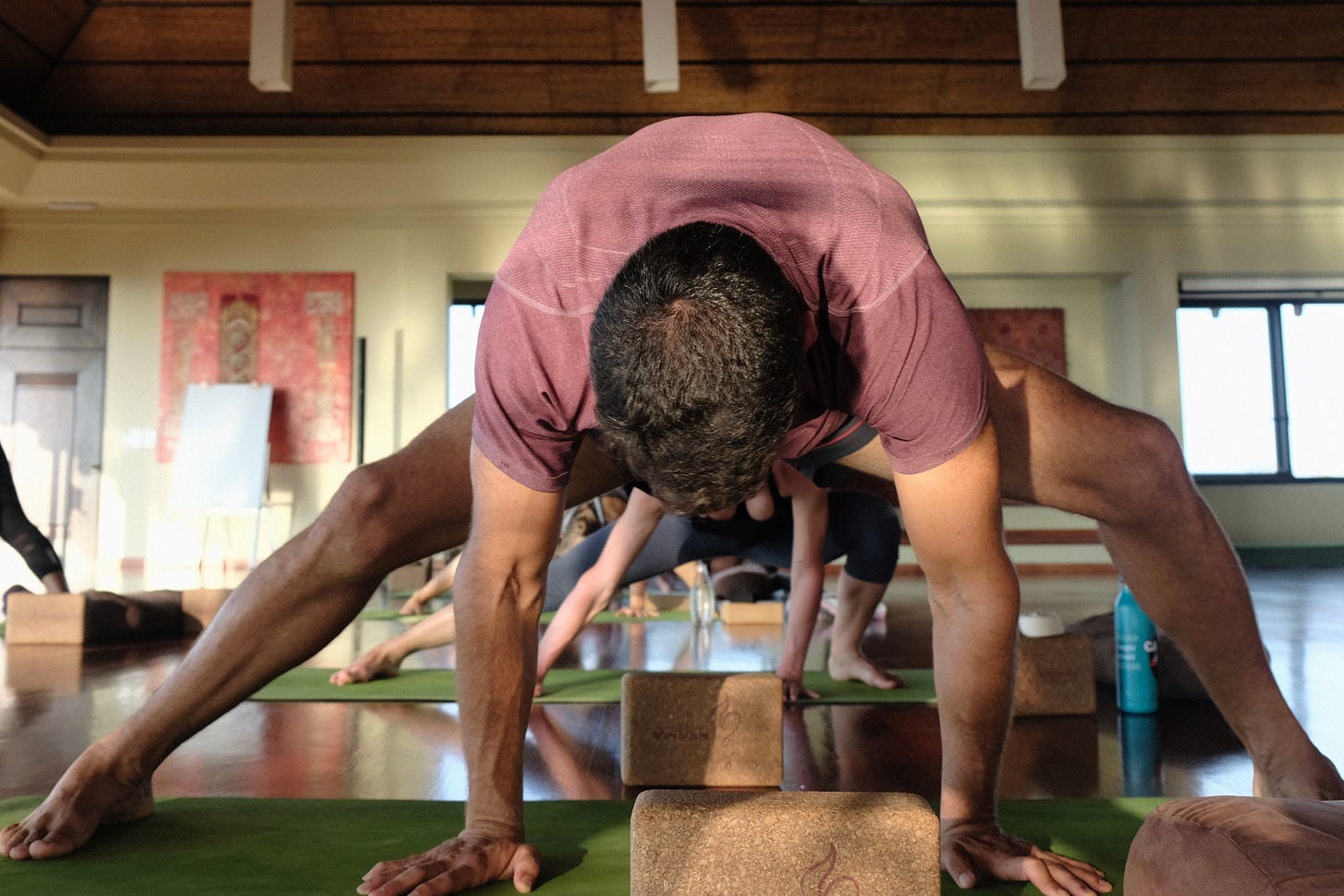Matcha: Japan’s revenge for WW2
The bitter truth about the hot beverage with the highest vibrations
It’s suddenly an arctic winter wonder-dystopia-land everywhere in the world except for LA, Guam, and the employee lounge at SeaWorld, and all you really want to do right now is curl up with a good self-helpdevelopment book, a fringed Loro Piana cashmere blanket and a piping hot cup of matcha, right?
Wrong. You’re such a liar.
Everyone who drinks matcha is lying to themselves and lying to their barista every time they say, “I’d like a matcha latte,” because no one actually likes matcha.
We’ve been misled to believe that matcha is delicious because it’s Japanese, and other than fish prostate (shirako) and raw chicken sashimi (torisashi) literally everything that comes from Japan is delicious. Matcha is not delicious. It’s sub-drinkable even with all of the gourmet, bougie shit that model-turned-yoga instructors who have expensive blue check marks and book deals (through Aunt Gwyneth) put into it, like “ceremonial” cacao, raw manuka honey, cinnamon, oat milk, and all of the super annoying non-psychoactive non-spaghetti-sauce mushrooms - you know the ones, lion’s mane, chaga, turkey tail, and the most annoying of them all, reishi. Matcha is so searingly gross that the recent influencer promotions of one of the Gen Z Instagram matcha brands that puts literally all of that shit into matcha so that you don’t have to (which I think defeats the point, because if you’re drinking matcha you want to be able to brag at floor parties about all of the things you put into it during your hour-long morning ceremony) acknowledges the universal understanding that no one actually likes matcha.
No matter what you put into matcha, it still tastes like the manicured front yard of a childless, post-sex, 40something couple in Mill Valley who both used to be bankruptcy lawyers but now have a transcendental meditation podcast for other suburban, childless, post-sex couples in their 40s.
Why is matcha so popular? Why have so many ostensibly smart, logical people with taste buds that haven’t been torched by drinking one too many bleach and battery acid martinis replaced coffee with matcha? I went on a quest to find out, and I started way back in a time when the word “vibe” wasn’t used as both a question and an answer by 30somethings.
It turns out people have been suffering through cups of matcha for over 1,400 years.
The matcha format of tea was first developed in the year 600 by growers and traders in China who wanted an easier way to transport their product, so they turned tea into bricks that were then pulverized into powder. Does this sound familiar? It should, because that’s exactly how Pablo Escobar created Wall Street in the 1980s. You didn’t see stock brokers drinking cocaine tea, though, did you? That’s because cocaine tastes terrible. Not that I’d know.
Matcha somehow evolved from a greed-fueled logistics play into an elective pursuit around the year 1000. The characteristic first-sip-of-matcha-grimace first spread across the otherwise serene faces of Chan Buddhist monks in the Tang Dynasty of China, who drank matcha to stay up all night and pray. Then the Samurai started drinking it to stay up all night and do murdery samurai stuff. Does this sound familiar? It should, because staying up all night and doing weird stuff is exactly what people use acid for. But you don’t see people at Burning Man and floor parties sipping acid, do you? No, you don’t. It isn’t sipped like something that tastes good, because acid tastes terrible. Not that I’d know.
A little while later, a Japanese monk called Eisai ritualized its consumption, making it vibey, which of course caught the attention of high society, because aimless rich people have always co-opted poor people who have purpose and seem chill. Matcha, despite its astonishingly bad taste, was thus cemented as something that wise, evolved, mindful and energetic but calm people in Japan drink. But how did it end up in the United States, where no one who meets that description has ever or will ever exist?
Fast-forward 800 years to Los Angeles, where most ruinous fads begin.
Los Angeles in the 1970s had a high concentration of Japanese immigrants who wanted to eat things that weren’t donuts, hamburgers and former child stars, so they created their own grocery stores and filled them with mostly delicious Japanese things that were hard to get outside of Japan, but also disgusting things like shirako, torisashi and matcha. Los Angeles in the 1970s also had a high concentration of basic, impressionable Americans with trust funds and way too much time on their hands who were seeking meaning and eternal youth. Japanese-Americans were still kind of annoyed with the United States for blowing a radioactive hole in their country of origin and then putting them in internment camps within their actual home country, so they started telling these basic, impressionable Americans with trust funds that matcha was actually a delicacy, and that it would give them both great skin and a chill vibe without staining their teeth brown like coffee (note that this is before Crest White Strips).
These same impressionable Americans with trust funds started evangelizing matcha to other impressionable Americans with trust funds, and between 1971 – when the first pungent pouch of lurid green mouth misery was sold in LA to probably one of the Getty kids – and today, matcha has become an essential part of the identity of a certain kind of person who lives not only in Venice Beach and the more expensive parts of Williamsburg, Greenpoint and Bushwick but also in every part of the country where marijuana and yoga are legal and estate taxes are low.
Who is the matcha drinker? Naturally I start by asking the matcha dealer: baristas.
“Just like, really beautiful sad people,” said Eva Cavenova, a barista at Café Kitsuné. I ask her anecdotally why there are not one but two little insouciant off-kilter dashes above the “e”s in the establishment’s name. “Oh, yeah, beautiful sad people like places with acute accent diacritic marks in the name,” she explained. “It kind of justifies paying $8 for a matcha latté. And that’s without tip, so.”
I pressed her for more details on this beautiful sad person who drinks eight-dollar pre-gratuity matcha lattés.
“Well, they’re usually either coming from yoga or going to yoga. You can tell because they’re carrying their mat, and they put it in a chair, like it’s a kid or something, which I think is kind of gross and rude, and they’re either wearing tights or like, really baggy colorful pants they probably bought in Holbox or Bali – and also one of those stupid fucking hats.”
I didn’t need to ask her any more questions, because I know exactly who she’s talking about, because I don’t know anyone in my life who isn’t exactly who she’s talking about.
The thing I don’t know at this point was whether or not — 15 years after literally (I shit you not) spending ten days in Kyoto sitting in really uncomfortable positions in temples with actual monks drinking ceremonial grade matcha in actual green tea ceremonies and talking for hours under the blazing sun in tea fields with farmers about their cultivation techniques, all so that I could credibly help Suntori, the biggest Japanese beverage company, launch a bottled green tea to impressionable Americans with trust funds — I would still find the taste of matcha crushingly terrible.
So after staring off into the distance past the acute accent dialectic mark of “e” in the cafe’s logo on the window and contemplating the fate of my mouth, I lied to Eva, “I’d like a matcha latté.”
She smirked and charged me eight dollars, pre-gratuity.
After what felt like an hour, she calls my name and “oat matcha latté” a little too loudly, and I walk up to claim my beverage, feeling embarrassed to be seen holding a matcha latte without one of those stupid fucking hats on my head.
I sit down and marvel at its color. If I were staring down at that same shade of green in a salad, I’d think I was on the useful kind of mushrooms. That kind of green should not exist outside of anime or the aquarium of a super poisonous frog. What is it doing in a perfectly good coffee mug?
I smell it. The banal oat milk doesn’t remotely dissipate the matcha’s odor. I can smell the thinly veiled spite of those intrepid Japanese grocery store owners in Los Angeles in the 1970s who duped the first generation of matcha converts.
I take a sip. The middle of my tongue is immediately assaulted with lawn, ripe pasture dirt, and gym socks (not that I’d know), and as I force myself to swallow the tiny sip, the rest of my mouth picks up notes of rotting pine trees, the goo you lick to activate an envelope’s stickiness, exposed copper wire and beautiful sadness. I take a breath, and then the melange of all of these olfactory nightmares rise into my sinuses, running through the cavities of my face like drunken, angry children determined to break everything in sight. As I lunge towards the barista counter to pour myself a complimentary glass of water, I wonder what life would be like if I subjected myself to an oat matcha latté on the reg. I wonder how people tolerate matcha without diluting it with the hundreds of unpronounceable chemicals and delicious but apparently bad-for-everything oils that make oat milk so frothable.
I stand, still reeling from the taste that has permeated my soul, and walk towards the door without making eye contact with Eva, because I have relegated $7.93 worth of the oat matcha latté she whisked and frothed for me to a luke-warm, wounded soldier. Just as I’m about to cross the threshold of the cafe, I notice two kids — probably eleven or twelve, no doubt the offspring of a private equity power couple who are in yoga class — sitting with iced matcha lattés. Like many things my generation has proliferated, I had hoped that the matcha trend would die when we all get into our 50s and stop giving a fuck about optics and realize we just need a really efficient, delicious morning energy delivery vehicle that isn’t cocaine chocolate. Because that shit is expensive. Not that I’d know.
But here was irrefutable evidence that the youngest generation capable of freely choosing and independently (well, dependently independently - you know what I mean) buying something had chosen to drink matcha. And they seemed to be enjoying it. And they were neither sad nor beautiful. Maybe their taste buds had evolved? Maybe this generation bore witness to the relentless hedonism of earlier generations and cultivated a taste for liquid stoicism and culinary sadism? I’ll never know, because I don’t talk to children, because they’re super annoying.
I do know this, though. Matcha makes ayahuasca taste like chocolate milk. Not that I’d know.












👏🏼 an excellent piece!!! I laughed out loud.